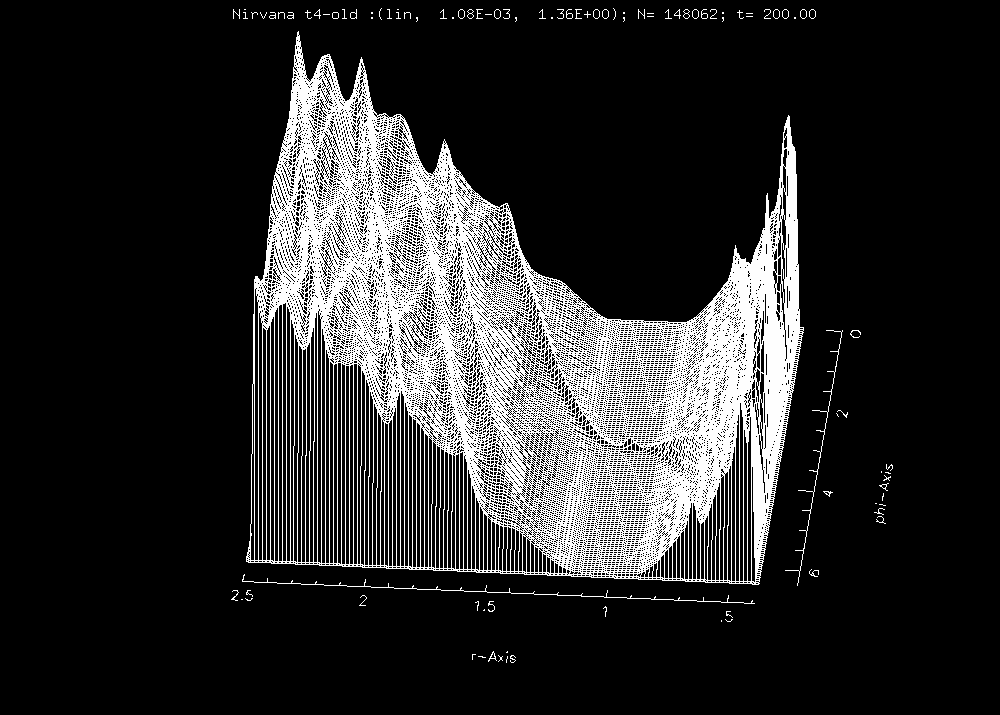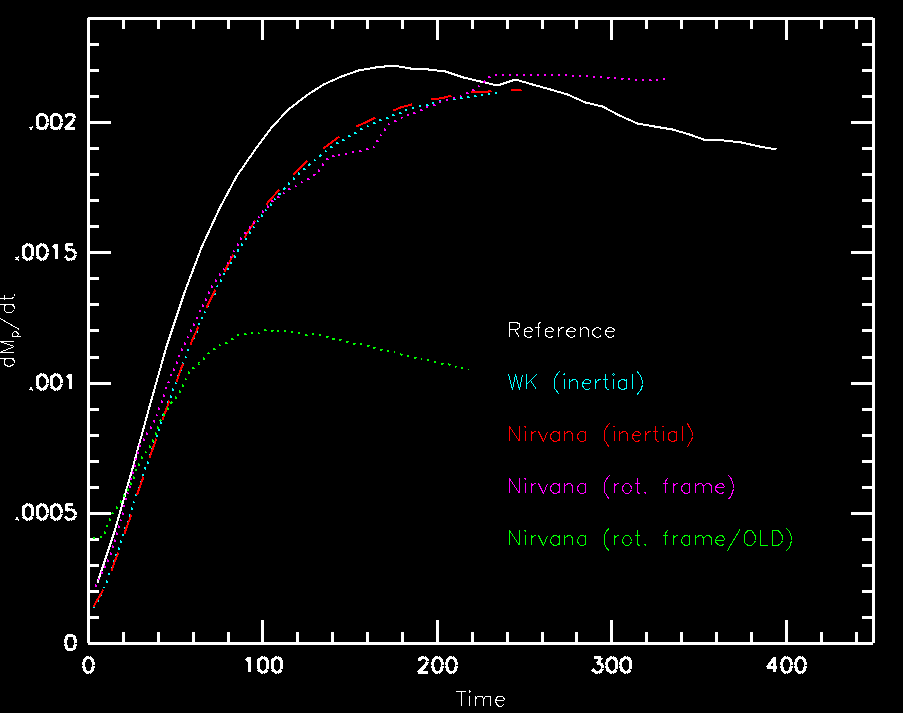Coriolis Forces in Disk/Planet Calculations
A comparison (Tests)
About the treatment of coriolis forces in calculations using a corotating
reference frame:
The details of the presented computations and a local finite difference analysis
you will find at the preprint server under
astro-ph/9808351.
Results are shown using the code
Nirvana
(developed originally by
Udo Ziegler
Heidelberg) and the code
RH2D (by Kley).
Two three dimensional mountain plots are presented for the Nirvana Code.
In the following figure
 the Coriolis force (for the
angular momentum equation) is given as an explicit source on the rhs.
of the equations. In the next figure
the Coriolis force (for the
angular momentum equation) is given as an explicit source on the rhs.
of the equations. In the next figure
 the Coriolis force is taken to the left
hand side and calculated with
the advection terms (NOTE: Only this treatment guarantees conservation
of total angular momentum).
The next figure
the Coriolis force is taken to the left
hand side and calculated with
the advection terms (NOTE: Only this treatment guarantees conservation
of total angular momentum).
The next figure
 displays the results for the inertial frame calculation.
displays the results for the inertial frame calculation.
The mountain plots are similar but have some (important) differences.
Obviously in the slope of the gap is shallower in the first treatment.
And only the conservative formulation yields the same structure
as the inertial frame calculation.
In turn, this leads to a substantially lower accretion rate through the planet
onto the gap as given in the next figure
 .
Shown is the total accreted mass by the planet (through the sink hole
within the Roche lobe).
Apparently, only the conservative treatment gives identical results of the
accretion rate in the inertial frame and the corotating frame.
Compare the red and purple line in the last figure. If the Coriolis
forces are treated as explicit source terms on the right hand side,
the mass accretion rate is reduced by more than a factor of two!
The first two lines (white and blue) give results with the RH2D-Code.
.
Shown is the total accreted mass by the planet (through the sink hole
within the Roche lobe).
Apparently, only the conservative treatment gives identical results of the
accretion rate in the inertial frame and the corotating frame.
Compare the red and purple line in the last figure. If the Coriolis
forces are treated as explicit source terms on the right hand side,
the mass accretion rate is reduced by more than a factor of two!
The first two lines (white and blue) give results with the RH2D-Code.
 the Coriolis force (for the
angular momentum equation) is given as an explicit source on the rhs.
of the equations. In the next figure
the Coriolis force (for the
angular momentum equation) is given as an explicit source on the rhs.
of the equations. In the next figure
 the Coriolis force is taken to the left
hand side and calculated with
the advection terms (NOTE: Only this treatment guarantees conservation
of total angular momentum).
The next figure
the Coriolis force is taken to the left
hand side and calculated with
the advection terms (NOTE: Only this treatment guarantees conservation
of total angular momentum).
The next figure
 displays the results for the inertial frame calculation.
displays the results for the inertial frame calculation.
 .
Shown is the total accreted mass by the planet (through the sink hole
within the Roche lobe).
Apparently, only the conservative treatment gives identical results of the
accretion rate in the inertial frame and the corotating frame.
Compare the red and purple line in the last figure. If the Coriolis
forces are treated as explicit source terms on the right hand side,
the mass accretion rate is reduced by more than a factor of two!
The first two lines (white and blue) give results with the RH2D-Code.
.
Shown is the total accreted mass by the planet (through the sink hole
within the Roche lobe).
Apparently, only the conservative treatment gives identical results of the
accretion rate in the inertial frame and the corotating frame.
Compare the red and purple line in the last figure. If the Coriolis
forces are treated as explicit source terms on the right hand side,
the mass accretion rate is reduced by more than a factor of two!
The first two lines (white and blue) give results with the RH2D-Code.